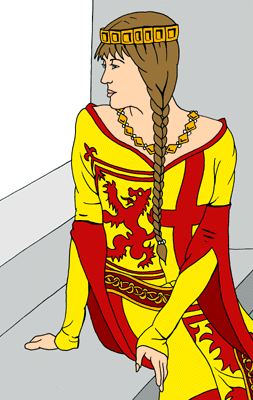 |
 |
|||
|
|
Elizabeth was the daughter of Richard de Burgh, Earl of Ulster, one of King Edward I’s most prominent and powerful Anglo-Irish supporters, by his wife, Margaret, apparently the daughter of Sir John de Burgh Senior of Lanvalay. She would have grown up at the English Court and on her father's extensive estates in Ireland. In the very late 13th century, Elizabeth was introduced to Robert Bruce, the Earl of Carrick and heir to Scottish throne. He had joined the English Court to gain the support of King Edward I, and possibly with the direct intention of allying himself with Elizabeth’s father. The Scottish widower had a young daughter to care for, so a match with Ulster’s daughter was an easy way of killing two birds with one stone. Elizabeth was a great beauty and about ten years his junior. They married in 1302, some say at Writtle, near Chelmsford in Essex, one of the Bruce's English manors. Four years later, after the defeat and execution of William Wallace, the Scots turned to Bruce to carry on their struggle for independence and, in defiance of Edward I, he assumed the Crown of Scotland. During his coronation at Scone Abbey, revelry outweighed the proper serious nature of the event and Elizabeth is said to have rebuked her husband for 'playing' at Kings and Queens like children (at the midsummer revels). She was evidently a lady of mature and earnest character. Only a week later, Robert the Bruce was soundly defeated by John of Lorne on the borders of Perthshire and Argyll. The situation was looking very grim and the King ordered the Queen to take her twelve-year-old step-daughter and flee north along with the his two sisters. They were escorted as far as Kildrummy Castle by the Earl of Atholl and the King’s brother, Neil Bruce. Here they found refuge for only a short time before the English placed them under siege. Because the castle was one of the strongest fortresses in Scotland, however, the enemy were eventually forced to revert to bribery to gain entry. It was the castle’s blacksmith who turned traitor and set fire to the grain stores in the great hall. This soon spread to the main gate and the garrison was quickly forced to surrender. Neil Bruce was captured and executed, but Elizabeth and the rest of her party managed to escape and desperately rode still further northward. They appear to have been making for Orkney but, stopping overnight in the sanctuary of St. Duthlac at Tain, they were captured by William, Earl of the Ross, an old supporter of her husband’s rival, John Balliol. The Royal ladies were all sent to England where they were kept sometimes together, but mostly apart. Queen Elizabeth was first held at Burstwick Manor in Holderness. She was probably saved from public humiliation due to the fact that her father were still a powerful ally of King. Conditions in her, relatively comfortable, prison were, however, not what she was used to; and she wrote to the English monarch to complain that she was only allowed to purchase three outfits for the whole year, and no headgear or bedclothes. However, over the next eight years of her imprisonment, things improved considerably as she was moved to better accommodation. In 1308, Elizabeth was confined to Bisham 'Abbey' Manor in Berkshire, a preceptory of the Knights Templar which Edward II had only very recently confiscated. She spent some four years there until March 1312 when, with the King increasingly at odds with his nobles and Bruce now raiding Northern England, she was moved down the road to the greater security of Windsor Castle. Queen Elizabeth spent the summer of 1312 at Windsor, before being moved on to Shaftesbury Abbey (Dorset) in the October, by which time the political situation in England had settled down and the Windsor household was probably required to concentrate on Queen Isabella who arrived there the following month for the birth of her eldest son. On 24th June 1314, King Robert at last defeated the English at the Battle of Bannockburn and the enemy's commander, Humphrey de Bohun, Earl of Hereford, was captured soon afterward. Negotiations soon led to his release in return for that of Queen Elizabeth, the Scottish Princesses and the aging Bishop of Glasgow. Elizabeth returned home to take her place at the centre of Scottish political life. Elizabeth and Robert had two daughters at this time, but no son. In 1316, the baby son of the King’s eldest daughter, Marjorie, became heir presumptive when his mother died due to complications caused by a riding accident shortly before his birth. Thus the situation remained until the Queen herself gave birth to a son, named David, at Dunfermline Palace, some eighteen years later! A second son followed but, sadly, he died in childhood. Elizabeth died at the Royal residence of Cullen Castle on 26th October 1327, at the age of only about forty-three. Her entrails were removed during the embalming process and buried in the Church of St. Mary the Virgin there. The rest of her body was taken to Dunfermline Abbey for burial, where it was joined, eighteen months later, by her husband, King Robert. A superb Victorian brass now marks their grave. Many thanks to Steve Lister for additional information on Queen Elizabeth's years of imprisonment.
|
|||
| © Nash Ford Publishing 2004. All Rights Reserved. | ||||



 Elizabeth
De Burgh,
Elizabeth
De Burgh,